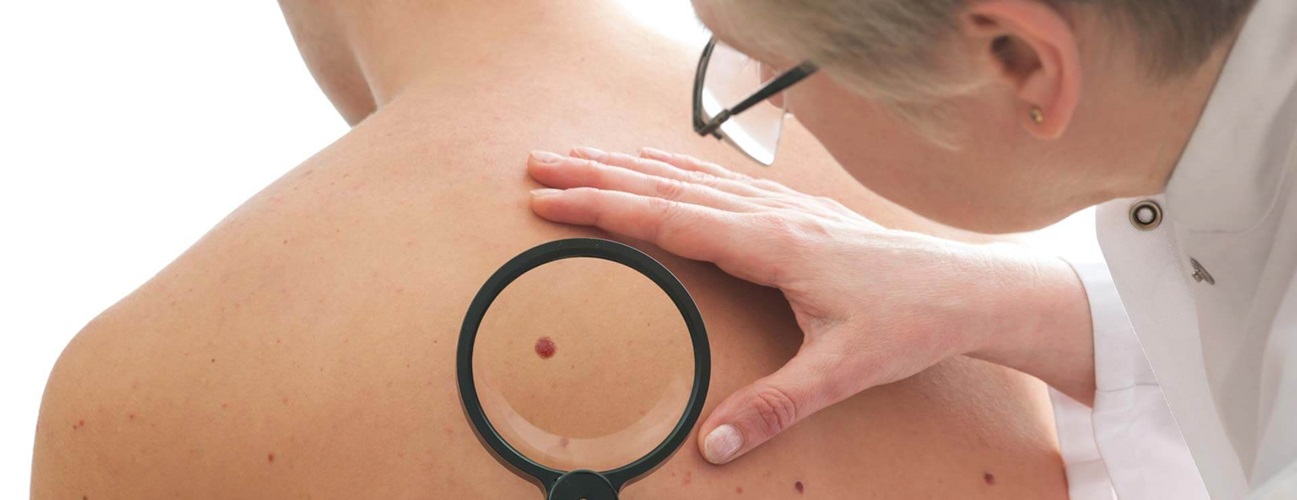Mohs Surgery
Featured Expert:
Mohs surgery is a highly specialized technique for treating skin cancer. Johns Hopkins dermatologic surgeon Elise Ng, M.D., explains the procedure.
What You Need to Know
- Mohs surgery is a precise and effective surgical technique used for the treatment of common skin cancers and certain rare forms.
- The goals of this treatment are to remove the cancer, minimize the chance of it returning and preserve as much healthy skin as possible.
- Mohs surgery is performed under local anesthesia on an outpatient basis, and the entire procedure usually lasts several hours.
- Depending on the extent of the cancer, reconstructive surgery may be necessary and can often be performed on the same day by your Mohs surgeon.
- The procedure is named for Frederick E. Mohs, the surgeon who developed the technique, and is also known as Mohs micrographic surgery.
Mohs Reconstructive Surgery: What Patients Need to Know
What is Mohs surgery?
Mohs surgery is a method for treating skin cancer lesions. During this procedure, the surgeon removes thin layers of skin one layer at a time and examines each layer under a microscope to determine if any cancer remains. This procedure continues until only cancer-free tissue remains.
Since its development, Mohs surgery has been refined into the most precise and advanced treatment for skin cancer, yielding success rates up to 99%. Mohs surgery is so effective because it evaluates the tissue surrounding the cancer more thoroughly than traditional skin cancer surgery techniques. As a result, it is considered the gold standard treatment for high-risk skin cancers, such as those located on the head and neck or those with aggressive growth patterns.
Why is Mohs surgery performed?
Mohs surgery can treat:
- Basal cell carcinoma
- Squamous cell carcinoma
- Melanoma
- Other forms of skin cancer
Your doctor may choose this method to address skin cancer that is:
- Large
- Has aggressive pathology (i.e., the cells show an infiltrative growth pattern)
- Located in a sensitive area where it is important to minimize the removal of normal healthy tissue, such as the head and neck, fingers, toes or genitals
- On a person with a suppressed immune system due to an organ transplant, lymphoma or other cause
- Recurring after previous treatment
Mohs Procedure: What to Expect
The Mohs procedure takes place in an outpatient setting with the surgeon using a local anesthetic to numb the area completely. After injecting the anesthetic, the surgeon uses a scalpel to remove thin, saucer-shaped layers of skin in a sequential manner.
Mapping is a critical part of the process, as it helps the surgeon plan the removal of each layer. The surgeon marks areas of the removed skin samples with colored dyes and makes a map of the surgical area using a freehand drawing or a computer application. The map provides a guide to the surgical area and aids the surgeon in identifying where cancerous cells are still being found.
Some cancers are deeply rooted in lower levels of the skin, appearing small on the surface but with extensive growth several skin layers below. Other cancers may be shallow and require removal of only a few small layers.
After each layer of tissue is removed, the specimen is frozen, sliced into very thin sections and processed onto glass slides by a Mohs histotechnician, a professional who is specially trained in preparing these slides. This process typically takes up to one hour.
The Mohs surgeon then examines the slides under the microscope to assess the extent of the skin cancer and identify microscopic roots. If tumor cells remain at any of the margins, the map is used to remove an additional tissue layer precisely at the area where cancer remains. This procedure continues until the tissue is cancer-free, which spares the maximum amount of healthy surrounding tissue.
Care After Mohs Surgery
The surgeon will dress the wound and provide care instructions. This may include a topical ointment, medication or special care instructions to reduce the risk of infection.
Reconstruction After Mohs Surgery
Some Mohs procedures may not require reconstructive surgery at all, but for those that do, the reconstruction can most often be performed by your Mohs surgeon immediately after the skin cancer has been removed.
If a Mohs surgery leaves a large defect in a visible or sensitive place such as the nose or the areas around the eyes or ears, you may need a skin graft (taking a patch of skin from elsewhere on the body) or local flap (moving a segment of nearby skin) to cover the defect and restore the function and appearance of the face.
Advanced cases that require more extensive reconstruction are performed in the operating room under sedation or general anesthesia. In these cases, your Mohs surgeon may coordinate your reconstructive work with a plastic, facial plastic or oculoplastic surgeon. A consultation with your Mohs surgeon will help determine what type of reconstructive surgery you will need.
Reconstruction After Mohs Surgery | Amber's Story
Mohs surgery for the removal of squamous cell carcinoma left Amber with a large wound on her face. Willing to travel anywhere for the best facial plastic and reconstruction surgeon, Amber found Lisa Ishii, M.D., at Johns Hopkins to repair her cheek and is delighted with the outcome.





